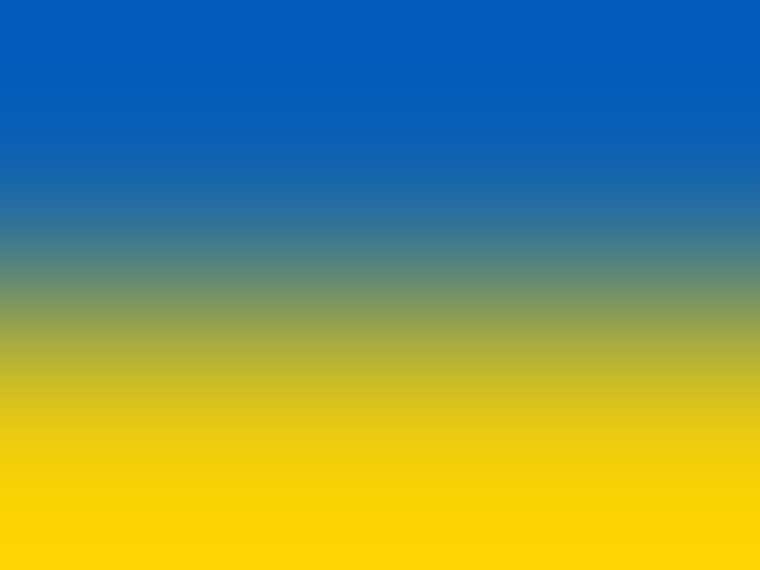Have you ever wondered what color blue and yellow make when combined? When you mix blue and yellow, the resulting color may differ slightly from what you expect.
Moreover, depending on the medium, the yellow and blue combination produces different colors.
In today’s article, we’ll look at what colors blue and yellow make when mixed in the RYB, RGB, and CMYK models.
You’ll also learn some useful tips and how to adjust the resulting color by creating shades and tints.
So, to begin, what do blue and yellow make when mixed in painting?
What Color Do Blue and Yellow Make With Paint Pigments?
What do you get if you mix blue and yellow? It’s pointless to keep it a secret any longer, and the answer is that you will get green.
Green is a secondary color (in the RYB model) that comes in various shades but is generally considered a cool color like blue.
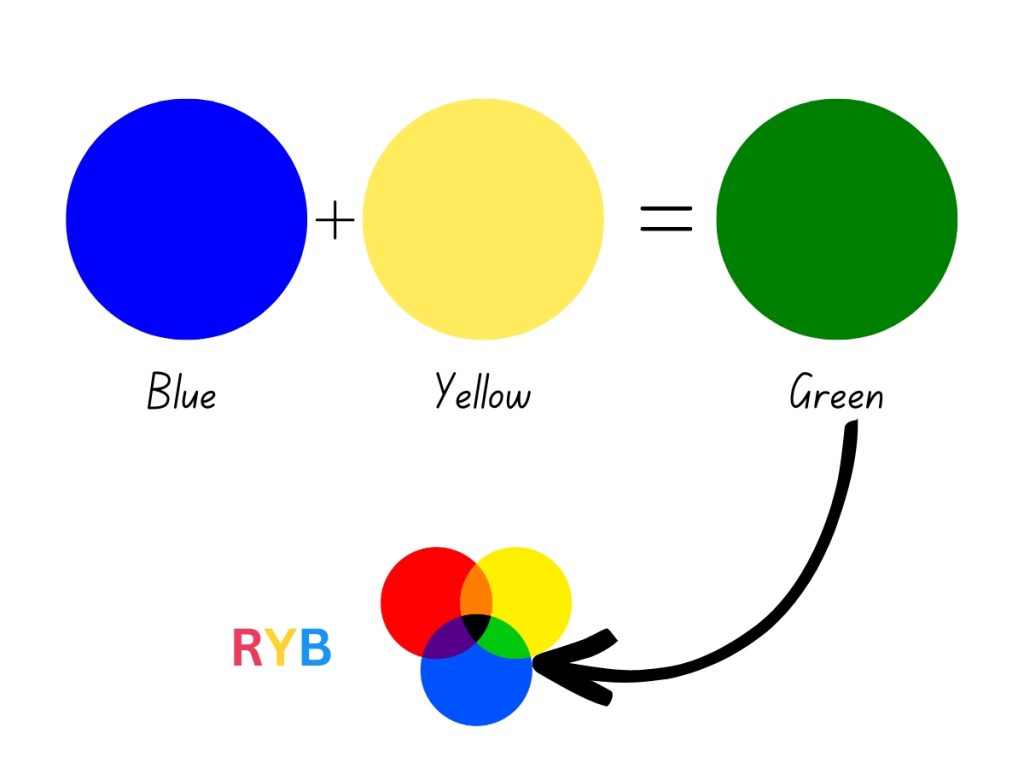
Blue and Yellow on the RYB Color Wheel
When it comes to painting, blue and yellow are both primary colors. By mixing them, the result is the secondary color green.
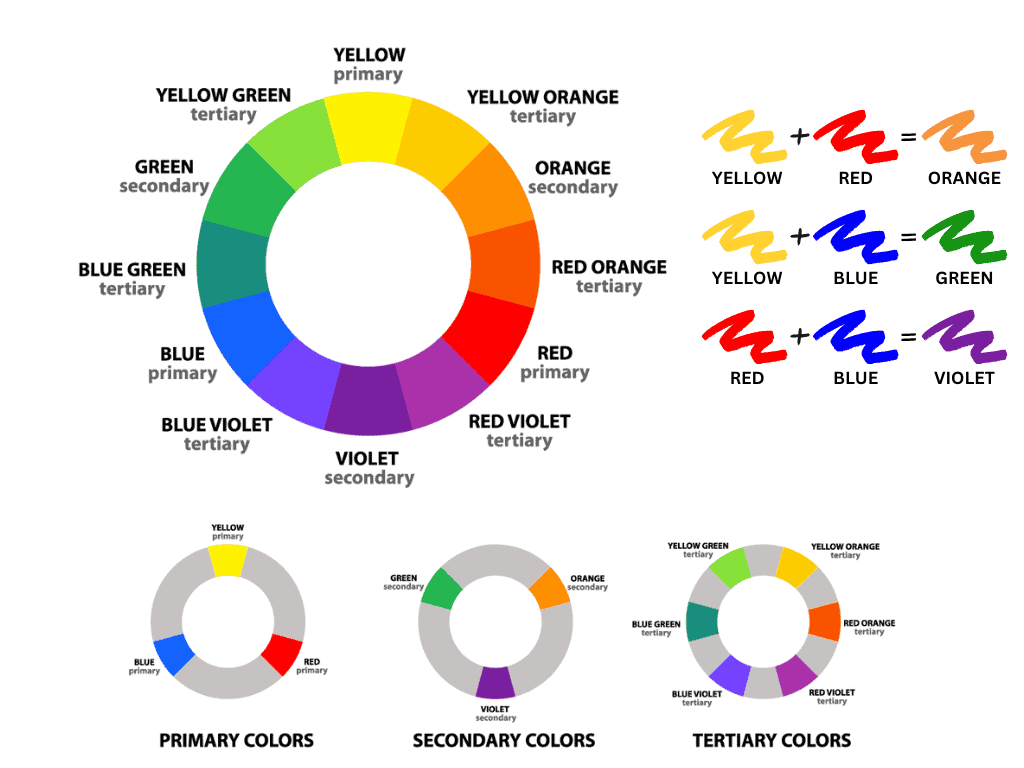
The other two secondary colors are purple and orange. So, for example, when you mix red and blue, you get purple. And when you combine red and yellow, you get orange.
Why Do Blue and Yellow Make Green?
When dealing with pigments and paints, the subtractive mixing process takes place.
In subtractive color mixing, blue paint reflects blue-green and blue colors but absorbs orange and red. Yellow paint, on the other hand, reflects yellow-green and yellow but absorbs purple and blue-green.
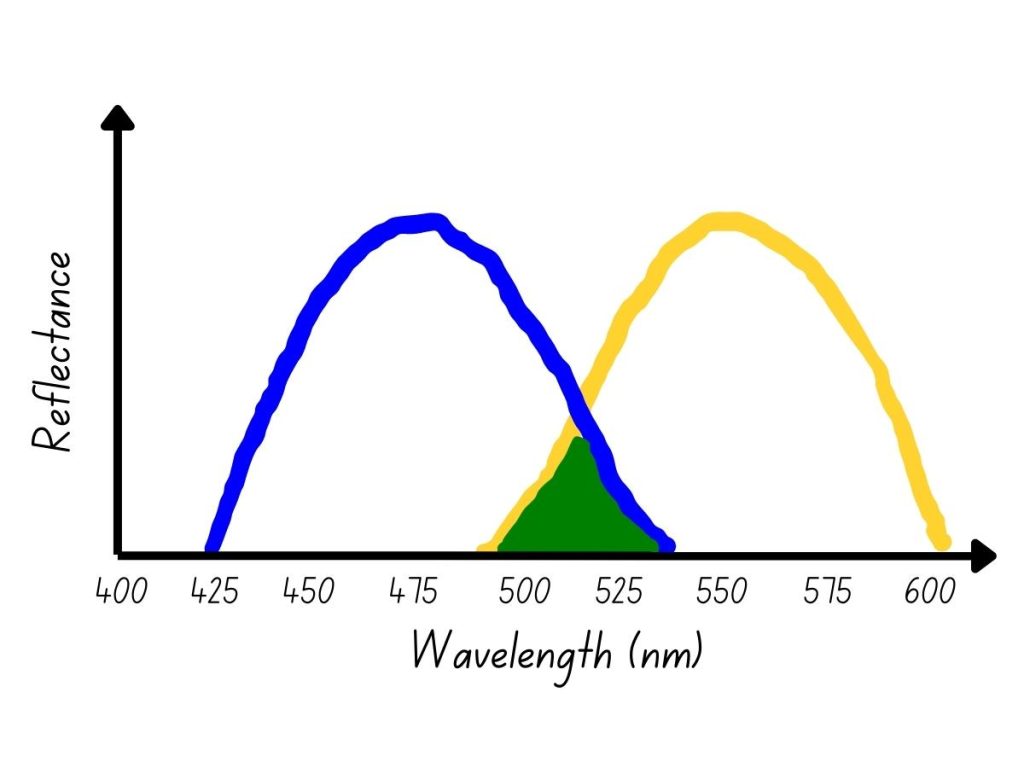
Blue paint absorbs most light at longer wavelengths and reflects light at shorter wavelengths. In contrast, yellow paint absorbs most light at shorter wavelengths and reflects light at longer wavelengths.
When blue and yellow paint are mixed together, they both reflect and transmit the middle wavelengths of light (green appearing) that produce green while absorbing the wavelengths of light that create other colors.
As a result, the mixture of blue and yellow paint appears green. This phenomenon is based on subtractive color mixing, occurring when pigments or dyes are mixed.
Are Blue and Yellow a Good Color Combination to Mix?
Mixing blue and yellow is a successful combination, as blue is a cool color. In contrast, yellow is generally a warm color. However, the color temperature is relative.
When mixing greens, one factor to consider is the temperature of the colors used. This is relative, as there are cool yellows and warm blues. This is because both blue and yellow can have a color bias.
Yellow can lean more towards green and become a cool greenish yellow. But, on the other hand, when it leans towards red, it becomes a warm reddish yellow.
The same is true for blue. Again, you can use a cool greenish blue or a warm reddish blue in the mix.
So color temperature is a crucial factor in mixing blue and yellow.
Yellow paints can go from cool to warm, as follows:
- Cadmium yellow
- Cadmium lemon
- Naples yellow
- Yellow Ochre
While cadmium lemon leans more toward blue, cadmium yellow has a red color bias.
If we would rank the types of blue paint from cool to warm, this would be the top:
- Manganese blue
- Cobalt blue
- Ultramarine blue
Manganese blue leans toward yellow, while ultramarine blue tends toward red.
So, depending on the temperature of the blue and yellow tones used in the mix, you can get a warmer or cooler green.
For example, if you mix light shades of blue with a medium yellow, you get a light green. If you do the same thing with a dark blue and a light yellow, you’ll get a darker green.
Do Blue and Yellow Go Well Together?
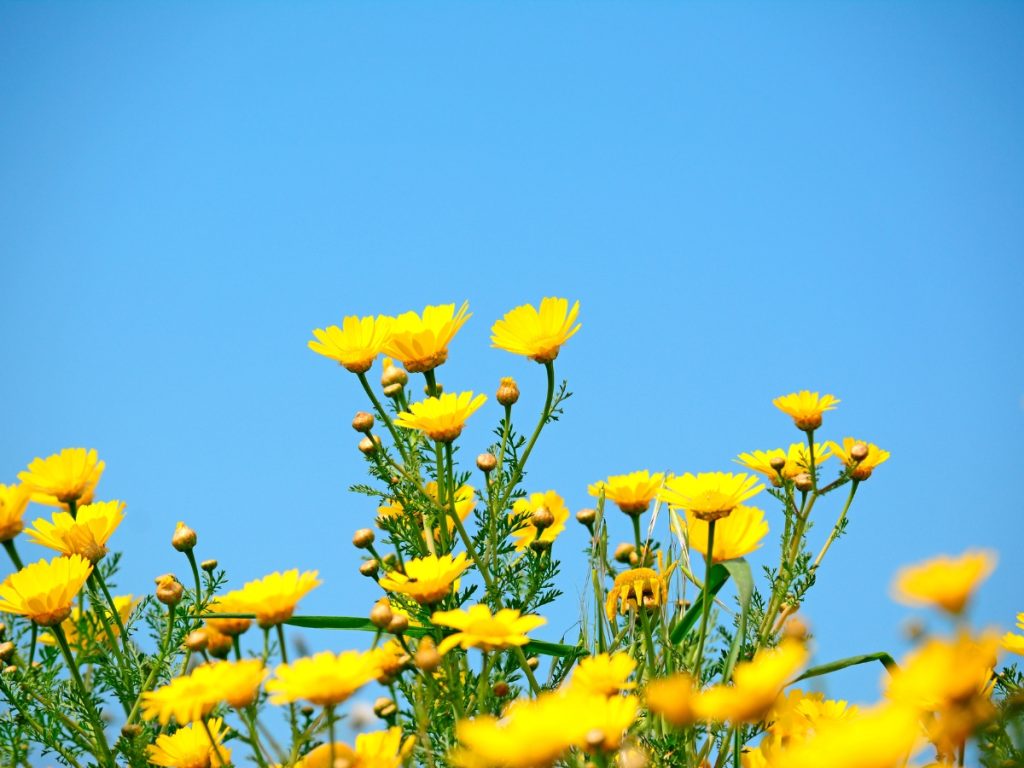
Blue and yellow go well together if you choose the right tones. For example, deep blues go well with yellow. Likewise, dark blue goes great with mustard yellow.
On the RGB wheel, blue is situated opposite yellow. This is called complementary color harmony. On the other hand, on the RYB color wheel, blue matches orange, while yellow is complimented by purple (or violet).
So, if you want to match them together, they work well in the digital medium. However, when it comes to art and interior design, you can match dark blue with mustard yellow. This is a successful match.
Can You Mix Blue and Yellow From Scratch?
Both blue and yellow are primary colors in the RYB color space. Therefore they cannot be created by mixing other colors. Yellow, definitely not.
When it comes to the CMYK color model, blue can be created by mixing the primary subtractive colors – cyan and magenta – in an equal ratio.
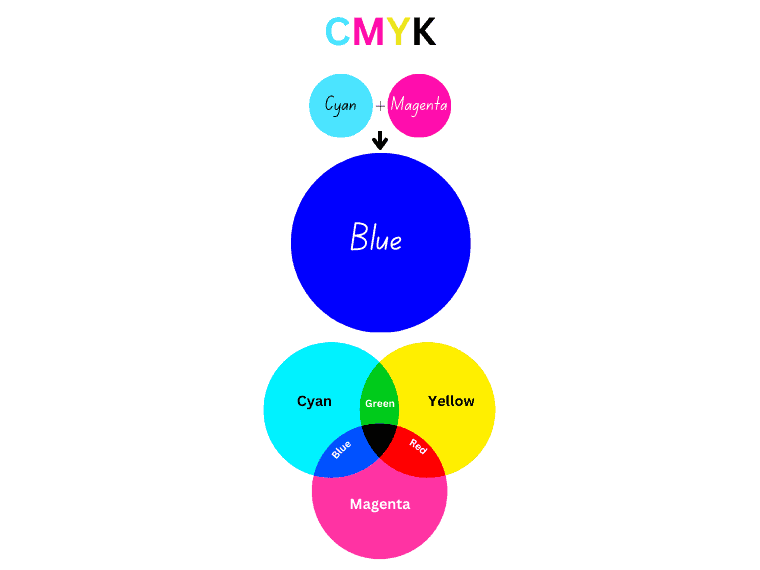
While cyan is a greenish-blue, magenta is a purplish-red. Mixing both produces blue.
Why Does Mixing Blue and Yellow Produce Different Greens?
Mixing paint is more complicated than it seems at first glance. That’s because the expected result might differ from what you get.
While some mixes will give you a muddy green, others may produce light green. It happens because it is difficult to find pure blue or yellow paint.
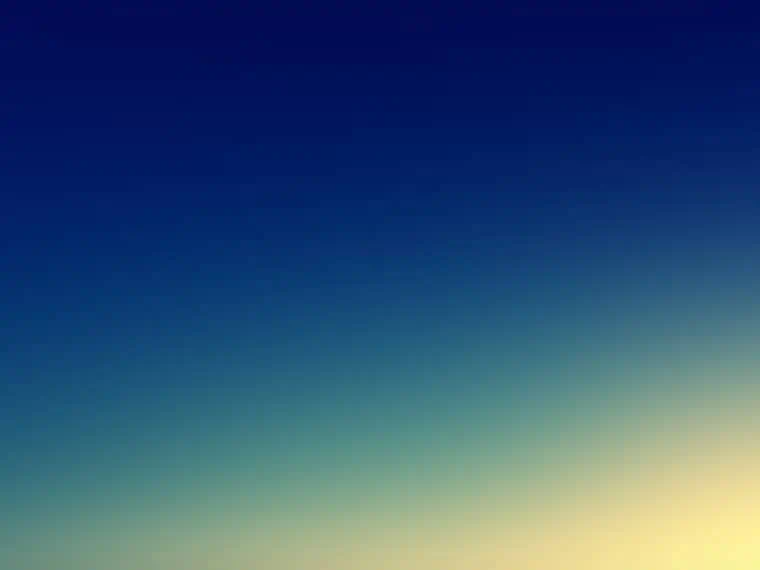
Mixing Different Shades of Green Paint
You’ve come to the right place if you’re still in doubt about what color blue and yellow make when mixed. Green is a secondary color but comes in multiple shades and tints.
Shades are created by adding black, while tints are created by adding white paint.
If you want to make a shade of green, the easiest way is to add a little black paint to your green base. For example, a little black can lead to a Forest green.
In addition to black, you can also add purple to darken your shade of green. If you are looking for a cool dark shade, use Dioxazine purple.
Making Tints of Green
If you want to create a light green, add some white paint. You’ll get a tint of green.
Even though adding white paint is the easiest way to make a tint of green, there are still other ways. For instance, adding yellow paint brightens and lightens the color green.
Making Tones of Green
Tones of green are created by adding black and white or gray to a base. An example of a tone is sage green.
If you want to make a sage green, mix 1 part blue with 2 parts yellow to get a green base. Then, add light gray paint until you reach the sage green shade.
If you want a bright grass green as a base, mix 1 part blue with 3 parts yellow.
Making a Warmer Green
To create a warmer green, blend yellow and blue to make a green base; then add Cadmium orange to the mixture.
You can also use Cadmium red to warm your green.
If you want to get a warmer, darker green, you can use Alizarin crimson.
You can use yellow ochre if you want a more earthy green with warm tones.
Making a Cooler Green
You can mix different cool shades of green by adding blue paint to the final mix.
If you want to create Emerald green, add Dioxazine purple to your green base. This will give you a cool, slightly dark green.
You can also cool down your green by adding Veronese green. It’s a shade similar to teal and can help cool down any green.
If you want to achieve a more saturated green, use Phthalo green. However, you will get a cooler, darker green.
Green Meaning
The color green is often found in nature, so it is linked to concepts of renewal, growth, and new beginnings.
This down-to-earth color symbolizes harmony, hope, and prosperity. Moreover, it has a revitalizing and relaxing effect.
On the other side, it may be connected to materialism, envy, and greed.
However, it symbolizes concepts related to life and rebirth. That’s because there are a lot of green things in nature.
What Color Does Blue and Yellow Ink Make?
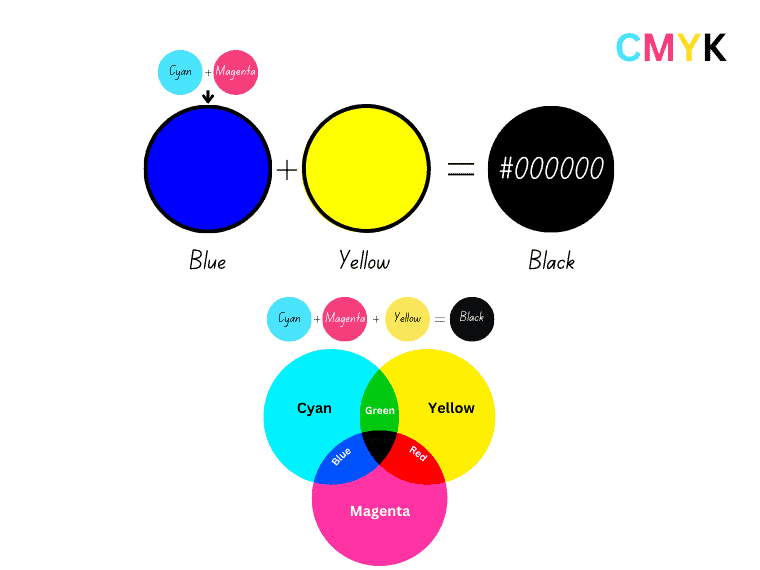
In the world of printing, blue and yellow are classified differently. Blue is a secondary color made from mixing cyan and magenta, while yellow is a primary color.
When we say the world of printing, we mean the CMYK color wheel. This uses cyan, magenta, and yellow as primary colors.
When you mix yellow and blue on the CMYK color wheel, you actually mix all the primary colors (cyan, magenta, and yellow). That’s because yellow is a primary color, while blue is created from cyan and magenta. Thus, mixing blue and yellow ink yields the color black.
CMYK and RYB are subtractive color models, but they have different uses. For example, CMYK is used in printing, while RYB is used in traditional art.
However, each uses different primary colors. While CMYK uses cyan, magenta, and yellow, the RYB model uses red, yellow, and blue.
In printing, CMYK also uses black ink (which stands for the fourth letter of the acronym)) to add blackness. Cost-effectiveness is another justification for doing this.
Black Meaning
The color black evokes power and elegance. Moreover, black is associated with sophistication, mystery, and formality.
Moreover, it is associated with prestige, authority, and protection. Although it looks intimidating, it is rather a color associated with protection.
However, it can also be connected to sadness, pessimism, and depression.
What Color Do Blue and Yellow Make in Lighting?
When it comes to light, there’s another color wheel to look at: RGB. This color space uses red, green, and blue as primary colors.
When mixing all three colors, you get white light.
While the blue in our mix is a primary color, yellow is a secondary color resulting from the overlap of red and green light.
So, mixing yellow with blue on the RGB color wheel mixes all three primary colors. In lights, red, green, and blue make white when mixed together. Thus, blue and yellow make white.
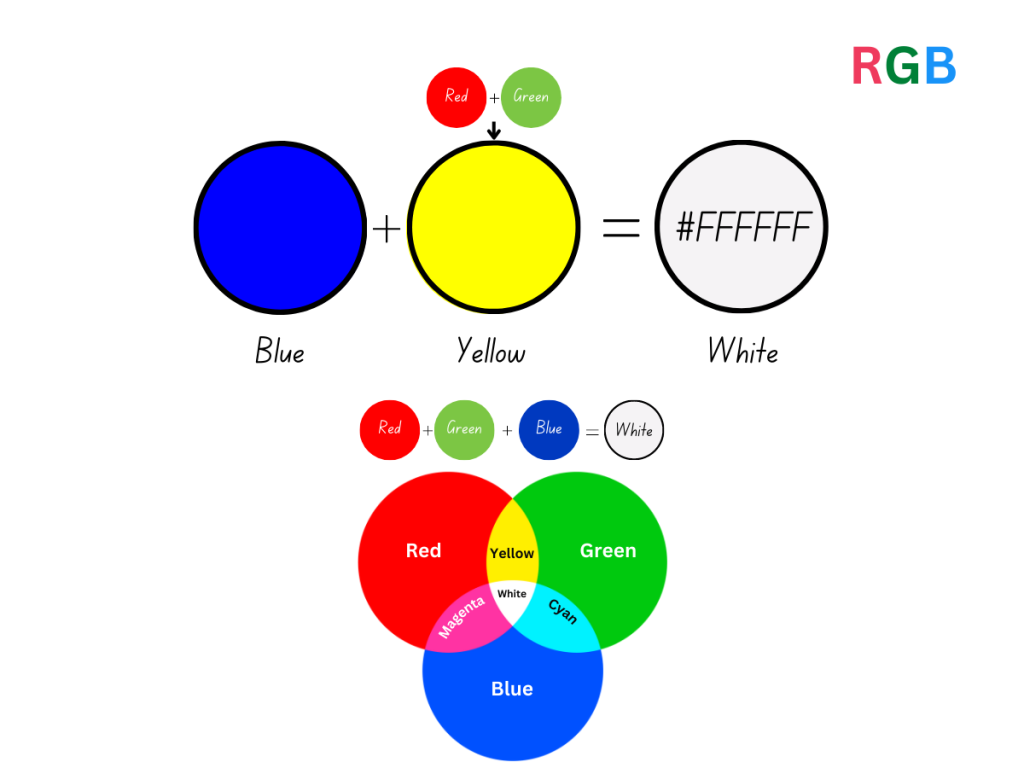
Regarding the mixing type, RGB is an additive color model. By mixing two primary additive colors, you get subtractive colors (cyan, magenta, and yellow).
Why don’t blue and yellow produce green in lights? Since green is a primary color, you cannot additively combine colors to create it.
Unlike traditional art that mixes ratios of paint, light mixes are overlays of different colored lights. It’s like overlaying the light of two flashlights on a wall. For example, white light can be created by overlapping red, green, and blue lights.
White Meaning
The color white symbolizes purity, innocence, and goodness. In addition, white is associated with new beginnings, faith, heaven, softness, and cleanliness. Moreover, white balances, simplifies, and refreshes.
On the other hand, it can symbolize coldness and emptiness. Others say it looks distant and dull.
How Can Yellow and Blue Make Different Colors When Mixed?
As you have seen, mixing yellow and blue produces different colors depending on your working medium.
While in painting, the mixture of blue and yellow make green, in ink, it makes black. On the other hand, in lights, it creates white;
Even if blue and yellow are mixed in subtractive models (RYB or CMYK), they result in different colors because they work with different primary colors.
The subtractive model is actually a theoretical color mixing model. In this pigment-based model, the more pigment you add, the less light is reflected. It starts with white and gets darker and darker as more pigment is added until it reaches black.
The additive model (known as RB) is a light mixing model. It starts with black and gets brighter as light is added. Finally, by mixing the three primary colors, you reach white light.
Did you enjoy this article about the blue and yellow mixture? Share this post with your friends who might be interested.

